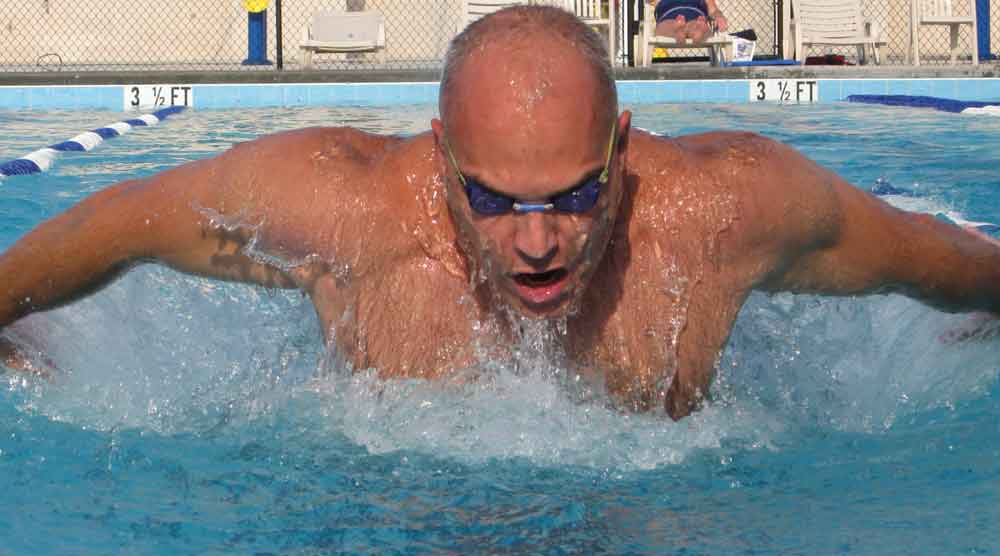Keep moving to prevent osteoarthritis, say physicists
Osteoarthritis in the knee is a painful condition affecting nearly half of all Americans at some time – and two thirds of obese adults. Research suggesting that physical activity could help prevent it has been presented this week at the AVS 62nd International Symposium and Exhibition, in San Jose, CA.
Yvette Brazier, Medical News Today 21 October 2015
Osteoarthritis is a degenerative bone disease resulting from a reduction in the cartilage, leading to an increase in friction.
Cartilage is a firm, rubbery material covering the ends of the bones in the knee joint. It reduces friction in the joint and acts as a “shock absorber.”
When cartilage becomes damaged or deteriorates, it limits the knee’s normal movement and can cause significant pain, and eventually the need for knee replacement surgery.
About 80% of the volume of cartilage tissue is made up of synovial fluid. This fluid is needed to support weight and lubricate joint surfaces. The loss of synovial fluid that causes the decrease in cartilage thickness, increase in friction, bone degradation and joint pain of osteoarthritis.
Since cartilage is porous, the synovial fluid is squeezed out of the holes over time. In fact, it is constantly leaking out into the membrane-walled cavity between the upper and lower leg bones.
| What stops cartilage from deflating? |
Yet the symptoms associated with osteoarthritis usually take decades to develop; so, what prevents the cartilage from deflating over the course of days, months or years, in the joints?
David Burris, an assistant professor in the Mechanical Engineering Department at the University of Delaware, and colleagues believe they know how motion can cause cartilage to reabsorb liquid that leaks out.
Scientists have previously hypothesized that if movement occurs faster than the fluid can diffuse, then continuous knee movement could prevent deflation.
Using a small sphere articulated against a cartilage plug, they showed that interstitial pressure was maintained indefinitely, if the contact area moved faster than the diffusive speed of the synovial fluid.
However, it remained unclear how a knee joint does not become deflated, given the long periods of time spent sitting and standing each day, without active input.
In other words, how does cartilage reabsorb the fluid that leaks out when people are not moving?
| Pressure forces fluid back into the cartilage |
Burris suggested that the reabsorption process might be driven by hydrodynamic pressurization. The term hydrodynamic refers to the lubricating principle involved in the working of bearings; in this case, the knee joint.
Hydrodynamic pressurization occurs when the relative motion of two surfaces causes fluid between them to accelerate in the shape of a triangular wedge.
For example, when a normal tire travels quickly over water, pressure builds until a film forms to lubricate the interface; this is called hydroplaning. Hydroplaning leads to a complete loss of frictional control. If the tire were porous, however, the exterior fluid pressure could force fluid back into the tire.
To investigate whether hydrodynamic pressurization could refill deflated cartilage, the researchers placed larger-than-average cartilage samples against a glass flat to ensure that there would be a wedge.
They found that at slow sliding speeds (less than would occur in a joint at typical walking speeds) cartilage thinning and an increase in friction occurred over time; but as the sliding speed increased toward typical walking speeds, the effect was reversed.
They concluded that hydrodynamic pressures, which force fluid flow into the cartilage, must have counteracted the fluid that had been exuded.
Burris says, “We observed a dynamic competition between input and output [of synovial fluid]. We know that cartilage thickness is maintained over decades in the joint, and this is the first direct insight into why. It is activity itself that combats the natural deflation process associated with interstitial lubrication.”
Source Medical New Today
| References |
Tribological Rehydration of Cartilage: A New Insight into an Old Problem, D. Burris, A.C. Moore. Invited Paper, Tribology Focus Topic, Session TR+AS+BI+NS-FrM7, AVS 62nd International Symposium & Exhibition, October 23, 2015 San Jose CA
Osteoarthritis and Articular Cartilage: Biomechanics and Novel Treatment Paradigms, Ray Marks, Advances in Aging Research, 2014, 3, 297-309. Published Online September 2014 in SciRes.
| Further reading |
Mapping the spatiotemporal evolution of solute transport in articular cartilage explants reveals how cartilage recovers fluid within the contact area during sliding, Graham BT, Moore AC, Burris DL, Price C. J Biomech. 2018 Apr 11;71:271-276. doi: 10.1016/j.jbiomech.2018.01.041. Epub 2018 Feb 8.
Sliding enhances fluid and solute transport into buried articular cartilage contacts, Graham BT, Moore AC, Burris DL, Price C. Osteoarthritis Cartilage. 2017 Dec;25(12):2100-2107. doi: 10.1016/j.joca.2017.08.014. Epub 2017 Sep 6.
Tribological rehydration of cartilage and its potential role in preserving joint health, Moore AC, Burris DL. Osteoarthritis Cartilage. 2017 Jan;25(1):99-107. doi: 10.1016/j.joca.2016.09.018. Epub 2016 Sep 30.
An analytical model to predict interstitial lubrication of cartilage in migrating contact areas, Moore AC, Burris DL. J Biomech. 2014 Jan 3;47(1):148-53. doi: 10.1016/j.jbiomech.2013.09.020. Epub 2013 Oct 31.
Fluid load support during localized indentation of cartilage with a spherical probe, Bonnevie ED, Baro VJ, Wang L, Burris DL. J Biomech. 2012 Apr 5;45(6):1036-41. doi: 10.1016/j.jbiomech.2011.12.019. Epub 2012 Jan 28.
Also see
Activity could help keep knees lubricated Science Daily

